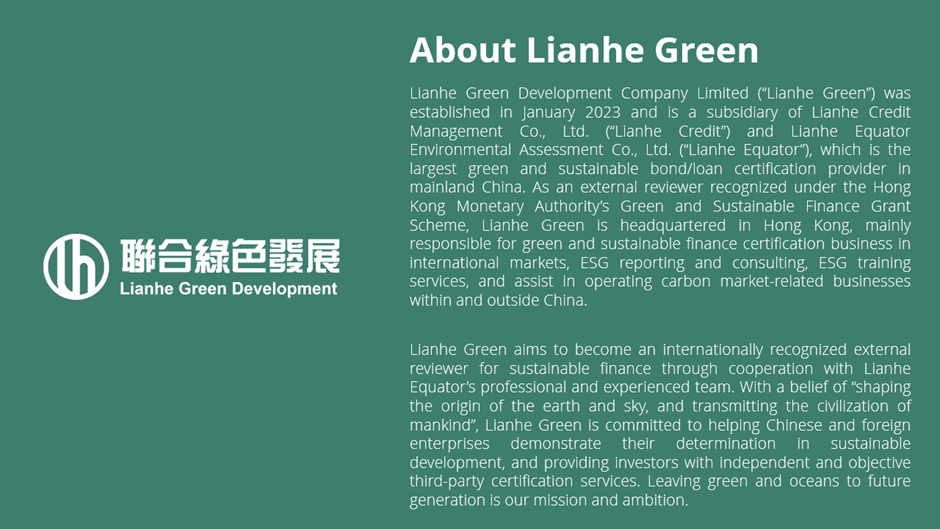 return
return
 current location:Home
current location:Home
 News and Events
News and Events
 News and Events
News and Events
 【ESG News】Global Trends Biweekly Newsletter Issue 26 (2025.1.27-2025.2.9)
【ESG News】Global Trends Biweekly Newsletter Issue 26 (2025.1.27-2025.2.9)
 return
return
 current location:Home
current location:Home
 News and Events
News and Events
 News and Events
News and Events
 【ESG News】Global Trends Biweekly Newsletter Issue 26 (2025.1.27-2025.2.9)
【ESG News】Global Trends Biweekly Newsletter Issue 26 (2025.1.27-2025.2.9)
category:News and EventsRelease time:2025-02-10

Hong Kong China ESG trends
Cross-Agency Steering Group sets 2025 priorities to support growth of sustainable finance in Hong Kong
The Green and Sustainable Finance Cross-Agency Steering Group (Steering Group) sets out three key priorities for this year to foster the growth of sustainable finance in Hong Kong following its meeting today (6 February). 1. Developing a comprehensive sustainability disclosure ecosystem. 2. Reinforcing Hong Kong’s role as a leading sustainable and transition finance hub. 3. Harnessing data and technology to facilitate sustainability reporting and promote sustainable financing activities.
Source: https://www.hkma.gov.hk/eng/news-and-media/press-releases/2025/02/20250206-3/
Lianhe Green Insight:
The Hong Kong Monetary Authority and the Inter-Agency Steering Group continue to promote the development of green and sustainable finance. This not only further consolidates Hong Kong's leading position in the international financial market but also demonstrates its strategic foresight. The focus this time is on the International Sustainability Standards Board (ISSB) standards, the expansion of Hong Kong's taxonomy for sustainable finance, and the development of the carbon market, especially the carbon trading market, which has been less frequently mentioned in the past. Among the three key areas of work, two explicitly involve carbon trading and carbon estimation tools.
Enterprises should plan ahead and comprehensively address the upcoming climate disclosure requirements, the development of transition finance, carbon screening and accounting, and energy-saving and emission-reduction targets. At the same time, strengthening talent training is also crucial to fully seize the market opportunities and growth potential brought about by the green transition.
International ESG trends
IFRS Foundation Releases Guide to Help Companies Report Climate-Only Disclosures Under ISSB Standards
The IFRS Foundation has published a new guide, Applying IFRS S1 when reporting only climate-related disclosures in accordance with IFRS S2, which aims to help companies understand how to report only climate-related information when applicable using International Sustainability Standards Board (ISSB) Standards.
The publication of this guide is part of the ISSB’s commitment to supporting the implementation of ISSB Standards, helping companies to prepare information and helping investors to receive decision-useful information.
When the ISSB was developing IFRS S1 General Requirements for Disclosure of Sustainability-related Financial Information and IFRS S2 Climate-related Disclosures, investors said they urgently needed climate-related information to inform decision making, and some stakeholders expressed concerns about data availability and companies’ readiness to provide information about other sustainability-related risks and opportunities.
In response to these concerns, the ISSB decided to provide transition reliefs in ISSB Standards, including the ‘climate-first’ transition relief, which is the focus of this new guide. When providing only climate-related information in accordance with ISSB Standards, companies are required to apply related requirements in IFRS S1.
Lianhe Green Insight:
The recent publication by the IFRS Foundation, the guide titled Applying IFRS S1 when Reporting Only Climate-related Disclosures in Accordance with IFRS S2, is highly consistent with the consultation summary of the Climate-related Disclosure Requirements issued by the Hong Kong Stock Exchange last year. Both emphasize the importance of climate-related information disclosure.
Hong Kong has implemented the new regulations in phases and provided detailed implementation guidelines to help companies comply in an orderly manner and play an active role in addressing the challenges of climate change. These measures have not only enhanced the transparency and sustainability of Hong Kong’s capital market but also further consolidated its position as a green finance hub in the Asia-Pacific region.
The EU May Exempt 80% of Companies from “Carbon Tariff”
According to a report by the Financial Times on February 6, the EU's climate policy chief said that the European Commission may consider exempting 80% of the companies covered by the upcoming Carbon Border Adjustment Mechanism (CBAM) from the carbon tax. The reason is that nearly 97% of the emissions covered by CBAM are generated by the 20% of companies included in the scheme.
EU Climate Commissioner Wopke Hoekstra said that he hopes to limit the taxation under the Carbon Border Adjustment Mechanism (CBAM) to the largest importers and exempt most companies from compliance costs and expenses. This is part of the EU's efforts to reduce red tape and boost productivity. Moreover, exempting small and medium-sized enterprises (SMEs) will not undermine the EU's climate goals.
The latest adjustments to the EU's Carbon Border Adjustment Mechanism (CBAM) reflect the common "focus on the major players and let the smaller ones go" logic in policy-making, with the core aim of balancing regulatory costs and emission reduction effectiveness.
Source: https://www.ideacarbon.org/news_free/64430/
Lianhe Green Insight:
If the EU’s Carbon Border Adjustment Mechanism (CBAM) exempts 80% of companies, it will temporarily alleviate the economic pressure on small and medium-sized enterprises (SMEs) caused by the carbon tariff. However, further details are still needed on how to identify the 20% of major-emitting companies. The proposed exemption strategy may be a transitional measure in the initial phase. As the mechanism matures, it is likely to gradually cover more companies and a broader range of products in the future. This strategy reflects a gradual logic of “focusing on the major emitters while exempting the smaller ones,” which not only reduces compliance costs for SMEs but also sets clear emission-reduction targets for high-emitting companies. In the long term, the mechanism will drive the global supply chain towards low-carbon and green transformation, while also promoting technological innovation and international cooperation.
BBC Publishes First Climate Transition Plan, Detailing How They Intend to be Net Zero by 2050
The BBC has unveiled its first Climate Transition Plan, outlining its roadmap to achieve Net Zero emissions by 2050. This milestone reflects the Corporation’s dedication to building a sustainable organization and influencing the wider media sector. Earlier this year, the BBC’s long-term climate goals received validation from the globally respected Science-Based Targets initiative (SBTi). The plan commits the organization to reduce all emissions—including direct (Scope 1 and 2) and indirect (Scope 3)—by at least 90% by 2050.
The strategy, developed in alignment with the Transition Plan Taskforce (TPT) Disclosure Framework, focuses on three pillars: 1. Ambition: Reducing, optimizing, and innovating energy use with low-carbon solutions. 2. Action: Equipping staff across operations, editorial, and production with skills to embed sustainability. 3. Accountability: Updating the plan at least every three years and maintaining transparency through climate-related disclosures.
Mainland China ESG trends
Notice on Deepening the Market-oriented Reform of New Energy Feed-in Tariffs to Promote High-Quality Development of New Energy
The Notice points out that, in accordance with the requirements of price market formation, fair responsibility, differentiation of stock and increment, policy coordination, deepen the new energy feed-in tariff market-oriented reform. Adhere to the direction of market-oriented reform, and promote new energy feed-in tariffs to enter the power market and form prices through market transactions. Adhere to the fair responsibility, improve the market transaction and price mechanism to adapt to the development of new energy, and promote the fair participation of new energy in market transactions. Adhere to the classification of policies, distinguish between stock and incremental projects, the establishment of new energy sustainable development price settlement mechanism, to maintain the policy convergence of the stock of projects, to stabilise the incremental project revenue expectations. Adhere to co-ordination, industry management, price mechanism, green energy consumption and other policies to synergise efforts to improve the power market system, to better support the new energy development plan to achieve the goal.
Source: https://www.ndrc.gov.cn/xxgk/zcfb/tz/202502/t20250209_1396066.html
Six Departments Issue the “Medium- and Long-term Plan for the Protection and Restoration of Natural Forests”
Recently, the National Forestry and Grassland Administration, the National Development and Reform Commission, the Ministry of Finance, the Ministry of Human Resources and Social Security, the Ministry of Natural Resources, and the Financial Regulatory Administration jointly issued the Medium- and Long-term Plan for the Protection and Restoration of Natural Forests. Based on a systematic summary of the achievements and experiences of the Natural Forest Protection Project over the past 20 years, the Plan provides a top-level design and comprehensive deployment for the protection and restoration of natural forests in the new era in China. It clarifies the overall requirements, strategic layout, objectives, tasks, and safeguard measures for the current and future periods.
The Plan proposes that by 2035, the natural forest protection and restoration system will be basically sound, the area of natural forests will be maintained at around 2.58 billion mu, the quality will have fundamentally improved, and natural forest ecosystems will be healthy, stable and fully functional. The Plan makes it clear that all natural forests and non-natural public welfare forests will be subject to integrated management and protection, the responsibility for management and protection will be fully implemented, and the management and protection capacity will be continuously upgraded, with an area of 3.235 billion mu under management and protection; systematic restoration will be carried out by adopting comprehensive measures of nurturing, reforming, and facilitating renewal, with a key focus on 401 million mu of forests that are urgently in need of quality upgrading; and the mechanism for optimising the livelihood protection of forested areas will continue to be optimised, and a bottom line of livelihood protection will be ensured for the employees of state-owned forestry units. livelihoods, promoting green development in forest areas, and strengthening infrastructure construction in forest areas.
Source: https://www.gov.cn/lianbo/bumen/202502/content_7002820.htm
Sustainable Finance Certification Public and Completed by Lianhe Green


